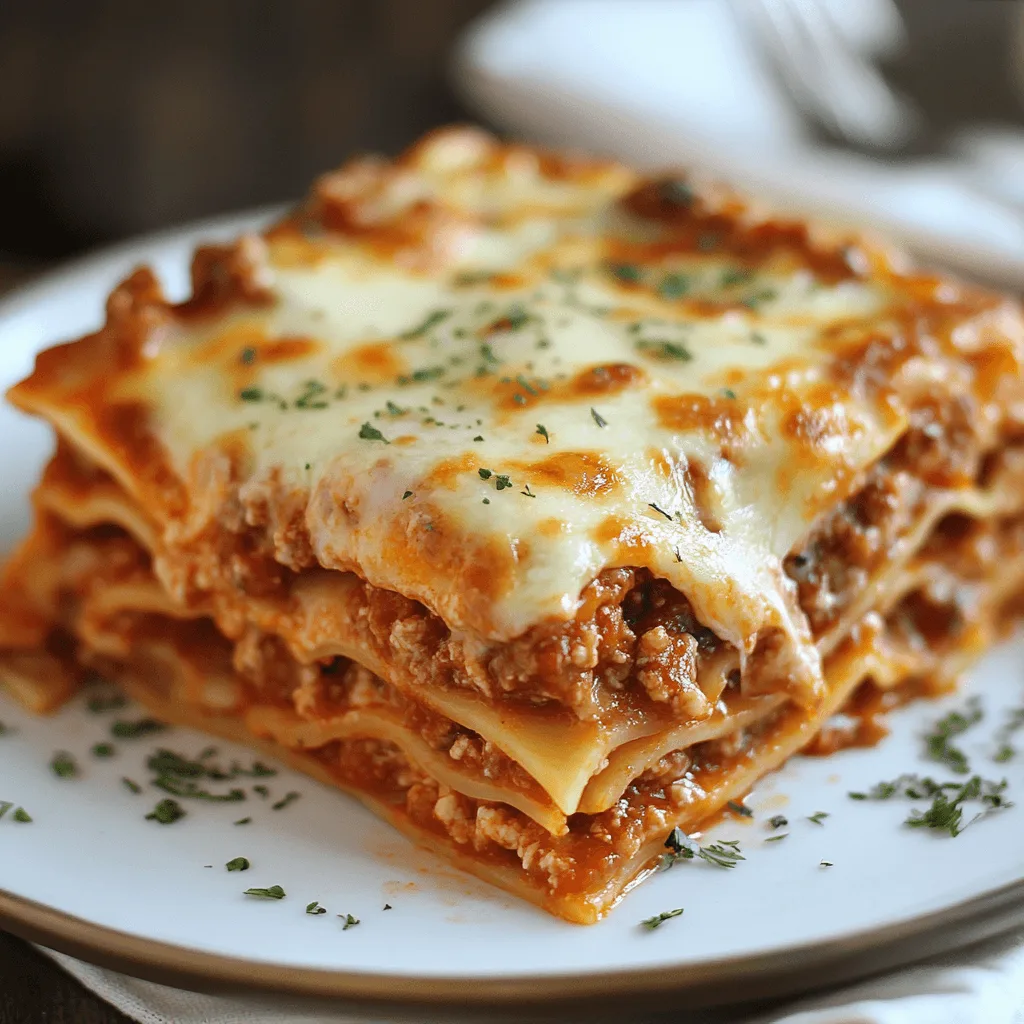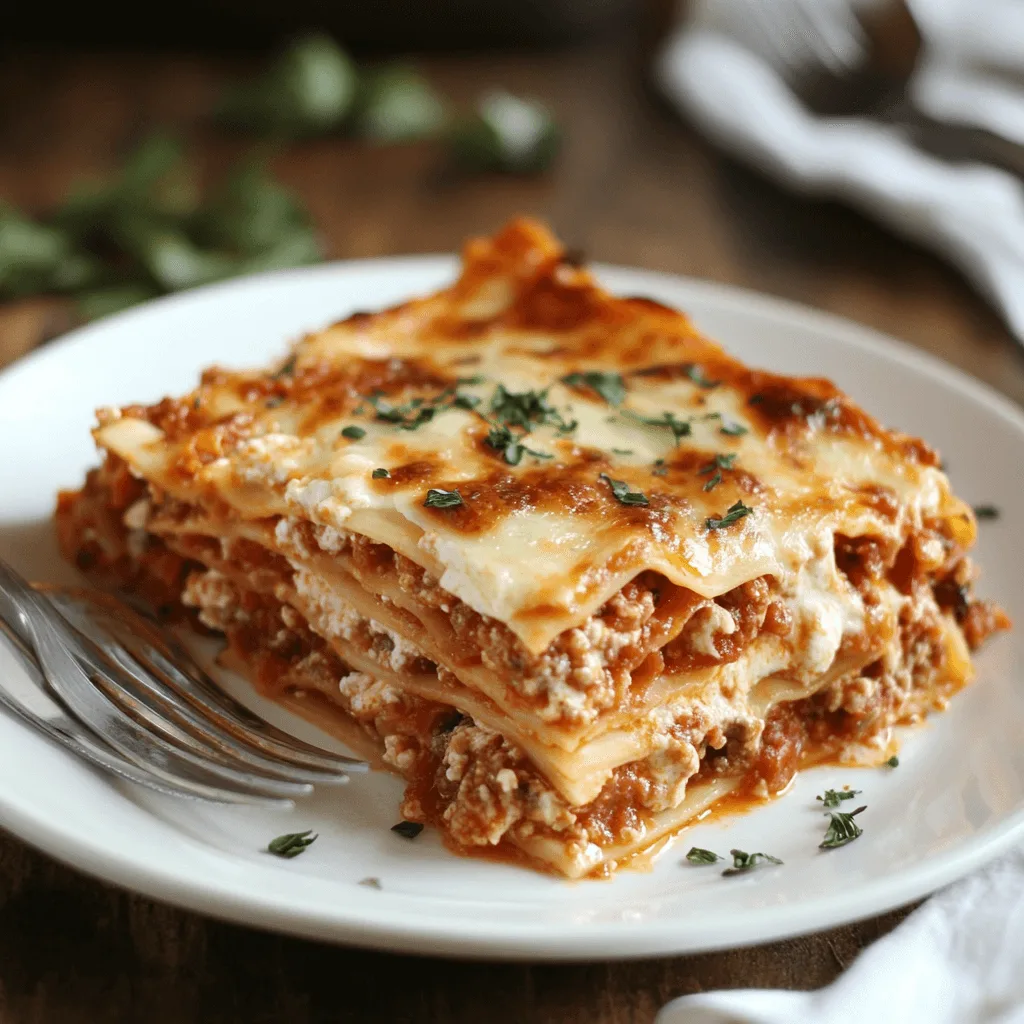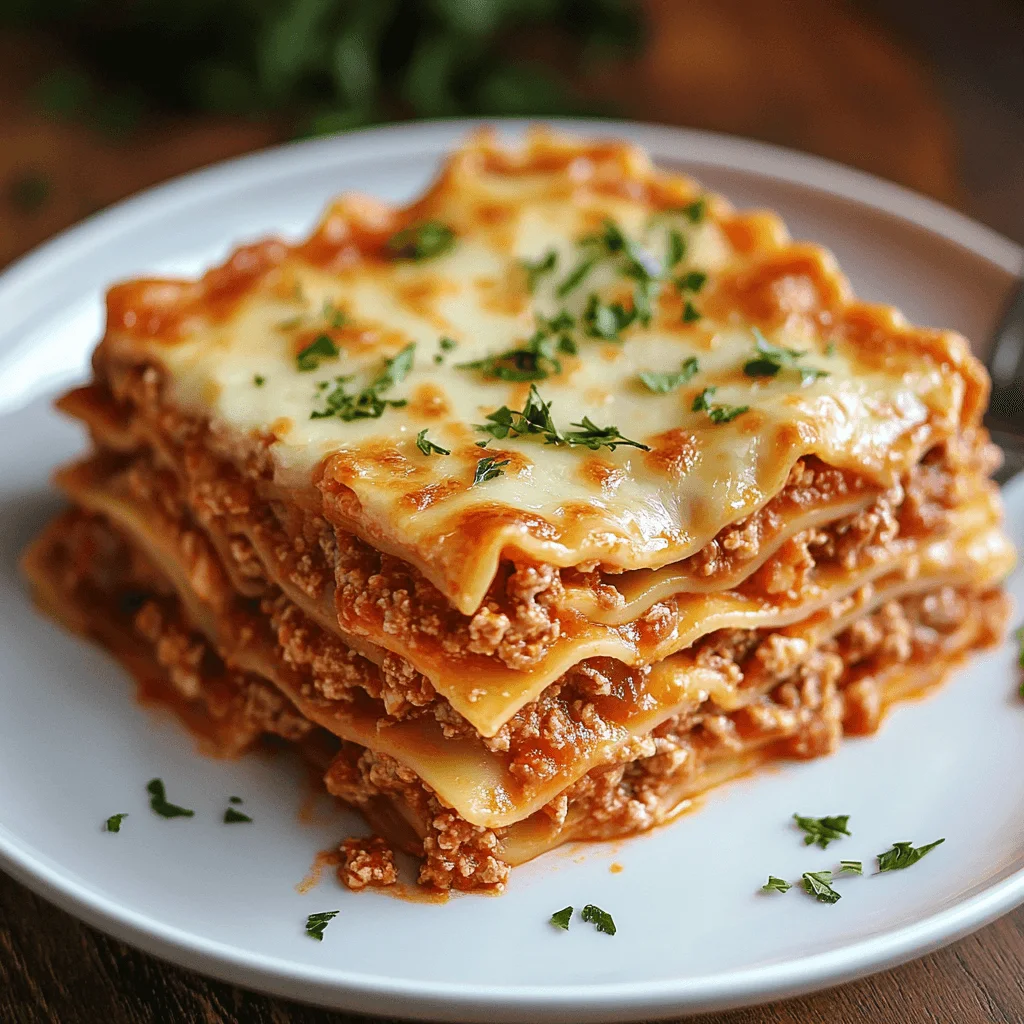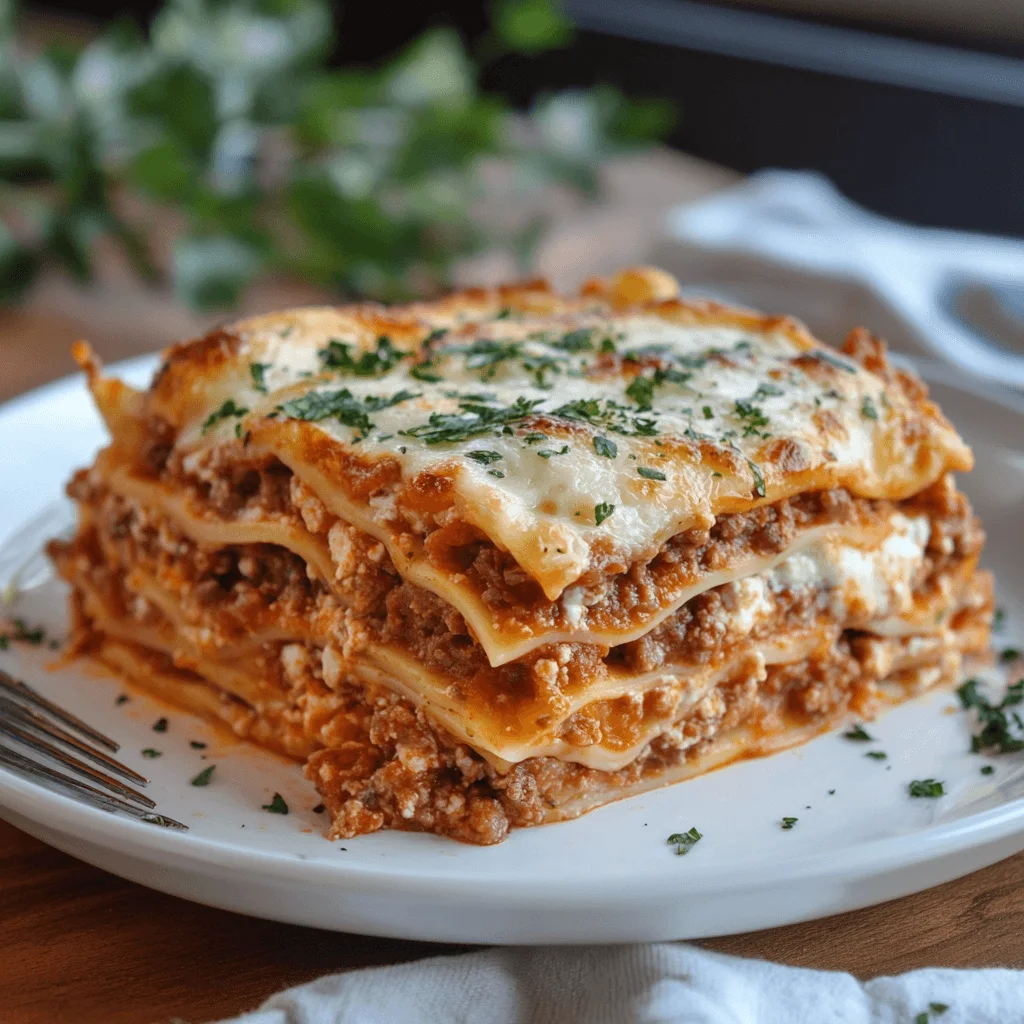Welcome to your go-to guide for a Quick and Easy Lasagna Recipe that promises a delicious dinner in under an hour. In today’s fast-paced world, finding the time to cook a wholesome, homemade meal can be challenging. That’s why this recipe is designed with busy weeknights in mind, offering a perfect blend of simplicity and taste without compromising on that classic Italian flavor.
This post will walk you through what makes this lasagna recipe truly unique. We’ll dive into the essential ingredients—think lasagna noodles, ricotta cheese, tomato sauce, and a blend of Italian herbs like basil and oregano—that combine to create a mouthwatering dish. You’ll also discover how a fast dinner recipe can be a lifesaver, transforming a hectic evening into a delightful culinary experience.
As you explore this guide, you’ll learn not just how to cook lasagna, but also how to optimize your kitchen routine with time-saving tips and straightforward cooking methods. Whether you’re a seasoned cook or just starting out, expect to uncover practical advice, ingredient insights, and a step-by-step process that makes preparing a delicious lasagna both accessible and enjoyable. Enjoy the journey to a satisfying dinner that’s ready in less than an hour!
Essential Ingredients and Tools

Primary Ingredients Spotlight
A successful lasagna starts with quality ingredients. Lasagna noodles serve as the foundation of your dish—they can be pre-cooked or no-boil, depending on your preference for texture and convenience. Ricotta cheese adds a creamy, smooth layer that balances the acidity of the tomato sauce. Its mild flavor blends perfectly with both the pasta and other cheeses. Mozzarella is essential for that satisfying, melty pull in each bite, while Parmesan cheese lends a sharp, salty finish that enhances the overall depth of flavor. Using fresh, high-quality cheeses and pasta can make a significant difference in your lasagna’s taste and texture.
Incorporating Italian Herbs and Seasonings
Italian herbs and seasonings are the heart of any authentic lasagna. Basil and oregano are must-haves, offering aromatic, slightly sweet, and peppery notes that brighten the rich layers of cheese and tomato sauce. In addition to these classics, a touch of thyme or rosemary can introduce subtle earthiness to your dish. Fresh garlic and a pinch of red pepper flakes can also be added to the sauce for an extra burst of flavor. These herbs not only enhance the taste but also create a well-rounded, balanced profile that makes your lasagna irresistibly savory.
Protein Options: Meat & Vegetables
To give your lasagna body and flavor, choosing the right protein is key. Traditional recipes often call for ground beef or Italian sausage, which infuse the dish with robust, meaty flavors when browned and simmered in tomato sauce. For a vegetarian twist, spinach is a fantastic substitute, offering both nutritional benefits and a pleasant, earthy taste. Other vegetable options—such as mushrooms, zucchini, or eggplant—can also be incorporated to add variety and texture. These proteins not only contribute to the dish’s heartiness but also complement the creamy cheeses and aromatic herbs beautifully.
Kitchen Tools and Equipment
Efficient tools and proper equipment streamline your lasagna-making process, ensuring a perfect dinner every time. Essential utensils include a large pot for boiling or prepping noodles, a sturdy baking dish that can evenly distribute heat, and a reliable skillet for browning meat or sautéing vegetables. A measuring cup and spoons are crucial for precise ingredient portions, and a mixing bowl helps combine cheeses and herbs seamlessly. For baking, set your oven to an ideal temperature of 375°F (190°C), and plan for a cooking time of about 30–40 minutes covered to allow the flavors to meld, followed by an additional 10 minutes uncovered to achieve a beautifully browned top. These tools not only enhance efficiency but also ensure that every layer of your lasagna is cooked to perfection.
Step-by-Step Recipe Instructions

Preparation and Pre-Cooking Steps
Before you begin assembling your lasagna, ensure your workspace and ingredients are ready to streamline the cooking process. Start by preheating your oven to 375°F (190°C)—this is the ideal temperature for even baking. While the oven warms up, prepare your ingredients:
- Cook the Noodles: If using traditional lasagna noodles, boil them in salted water until al dente. Drain and set aside, or use no-boil noodles to save time.
- Prepare the Sauce: Simmer your tomato sauce with garlic, onions, and Italian herbs like basil and oregano to develop a rich, deep flavor.
- Chop and Measure: Dice any vegetables and pre-cook your chosen protein (such as ground beef or sausage) with a bit of seasoning. Measure out cheeses like ricotta, mozzarella, and Parmesan so that everything is ready when you start assembling.
This organized approach minimizes last-minute scrambling and ensures that every component is perfectly prepped for layering.
Layering Techniques for a Perfect Lasagna
Achieving a balanced, flavorful lasagna hinges on the art of layering. Here’s how to build a harmonious dish:
- Start with Sauce: Spread a thin layer of tomato sauce on the bottom of your baking dish. This helps prevent sticking and kick-starts flavor integration.
- Layer the Noodles: Place a single layer of lasagna noodles over the sauce, ensuring they slightly overlap for complete coverage.
- Add Cheeses: Dollop a layer of ricotta cheese evenly, then sprinkle a generous amount of shredded mozzarella and grated Parmesan.
- Incorporate Protein: Distribute your cooked meat or vegetables uniformly over the cheese.
Repeat these layers—sauce, noodles, cheese, and protein—until you reach the top of your dish. Finish with a final layer of sauce and a topping of cheese to create a beautifully browned, bubbling finish.
Cooking Process and Time-Saving Tips
Once your lasagna is assembled, follow these steps to ensure it bakes evenly and quickly:
- Baking: Cover the baking dish with aluminum foil to trap moisture and bake for 30–40 minutes. Removing the foil for the final 10 minutes allows the top to brown and the cheese to crisp up.
- Time-Saving Tips:
- Pre-prepare Components: Make your sauce and protein in advance; store them in the refrigerator until needed.
- Use No-Boil Noodles: These can significantly reduce preparation time since they don’t require pre-cooking.
- Streamline Prep: Organize your ingredients and utensils beforehand so that each step flows smoothly.
Following these steps helps maintain a steady workflow and ensures your lasagna is both delicious and ready on time.
Troubleshooting Common Issues
Even with meticulous preparation, a few challenges might arise. Here are some quick fixes to common lasagna issues:
- Excess Moisture: If your lasagna seems watery, the sauce might need further reduction. Let it simmer longer to evaporate excess water, or pat pre-cooked noodles dry with paper towels.
- Under-Cooked Noodles: Ensure traditional noodles are cooked al dente before layering. For no-boil noodles, make sure there’s enough sauce to soften them during baking.
- Overly Browned Top: If the cheese browns too quickly, loosely cover the dish with foil for part of the baking time or lower the oven temperature slightly.
- Uneven Layers: Press down gently on each layer during assembly to help them meld together evenly, ensuring a uniform texture and flavor throughout the dish.
By addressing these potential pitfalls with simple adjustments, you can guarantee a perfectly balanced and delicious lasagna every time.
Variations, Serving, and Storage Ideas

Customizing Your Lasagna
Customizing your lasagna is a great way to tailor the dish to your taste and dietary needs. For a twist on the classic, consider mixing in different types of cheeses. While the traditional combination of ricotta, mozzarella, and Parmesan provides a rich and creamy texture, you might also try adding provolone for extra meltiness or a bit of goat cheese for a tangy note. In addition, incorporating a variety of vegetables can boost both the nutritional value and flavor complexity. Think about layering in spinach, sautéed mushrooms, zucchini slices, or roasted eggplant to add color, texture, and a burst of freshness. Experimenting with these variations allows you to create a lasagna that’s uniquely yours while still delivering the comforting flavors you love.
One-Pot Lasagna: A Quick Alternative
For those looking to minimize cleanup and save time, the one-pot lasagna variation is a fantastic option. This method involves cooking all the components in a single, deep skillet or oven-safe pot. Start by browning your choice of protein or vegetables directly in the pot. Then, add your sauce along with a measured amount of water or broth to help soften no-boil noodles as they cook in place. Layer the noodles, cheeses, and any additional vegetables right in the same vessel, allowing the flavors to meld together during the simmering process. Finally, transfer the pot to the oven for a short period to melt and slightly brown the cheese on top. This streamlined technique not only simplifies the cooking process but also intensifies the dish’s flavor by letting all the ingredients interact directly.
Serving Suggestions and Pairings
Complementing your lasagna with the right sides and beverages can transform it into a complete, satisfying meal. A crisp, mixed green salad dressed with a light vinaigrette offers a refreshing contrast to the richness of the lasagna. Pairing it with garlic bread or a slice of crusty Italian bread can help soak up any extra sauce while adding a delightful crunch. When it comes to drinks, consider a medium-bodied red wine such as Chianti or Sangiovese, which pairs well with the tomato-based sauce and savory flavors of the dish. For non-alcoholic options, sparkling water with a splash of lemon or a light beer can provide a refreshing complement. These pairings not only enhance the dining experience but also balance the meal, making your lasagna dinner even more memorable.
Storing Leftovers and Reheating Tips
Lasagna is one of those dishes that often tastes even better the next day, making it perfect for leftovers. Once your lasagna has cooled to room temperature, cover it tightly with plastic wrap or aluminum foil, and store it in the refrigerator for up to 3–4 days. For longer storage, consider freezing individual portions in airtight containers or freezer bags, which can keep for 2–3 months. When reheating, you have a couple of options:
- Microwave: Heat individual servings on a medium setting, stirring halfway through to ensure even warming.
- Oven: Reheat in a preheated oven at 350°F (175°C) for 15–20 minutes until the lasagna is heated through, which can help retain a slightly crispy top.
A final touch, like a sprinkle of freshly chopped basil or oregano, can revive the flavors and aroma, ensuring that each bite is as delicious as when it was first baked.
Conclusion
In conclusion, this Quick and Easy Lasagna Recipe is designed to transform busy weeknights into a delightful culinary experience without compromising on flavor. By using quality ingredients like perfectly cooked lasagna noodles, a rich blend of cheeses, and aromatic Italian herbs, you can create a lasagna that’s both hearty and satisfying. The step-by-step preparation, thoughtful layering techniques, and clever time-saving tips make it accessible for cooks of all levels, ensuring a consistent, delicious result every time.
Moreover, the flexibility of the recipe allows for creative customizations—whether you opt for different cheeses, add a variety of vegetables, or even try the one-pot method to minimize cleanup, there’s a version of this dish to suit every taste and lifestyle. Complement your meal with a fresh salad, crusty bread, or a well-paired wine, and you’ll have a complete dinner that not only tastes great but also feels like a celebration of Italian comfort food.
Finally, with practical advice on storing leftovers and reheating, you can enjoy the flavors of your homemade lasagna again and again. Enjoy your cooking journey, and don’t hesitate to experiment with the recipe to make it uniquely your own!

